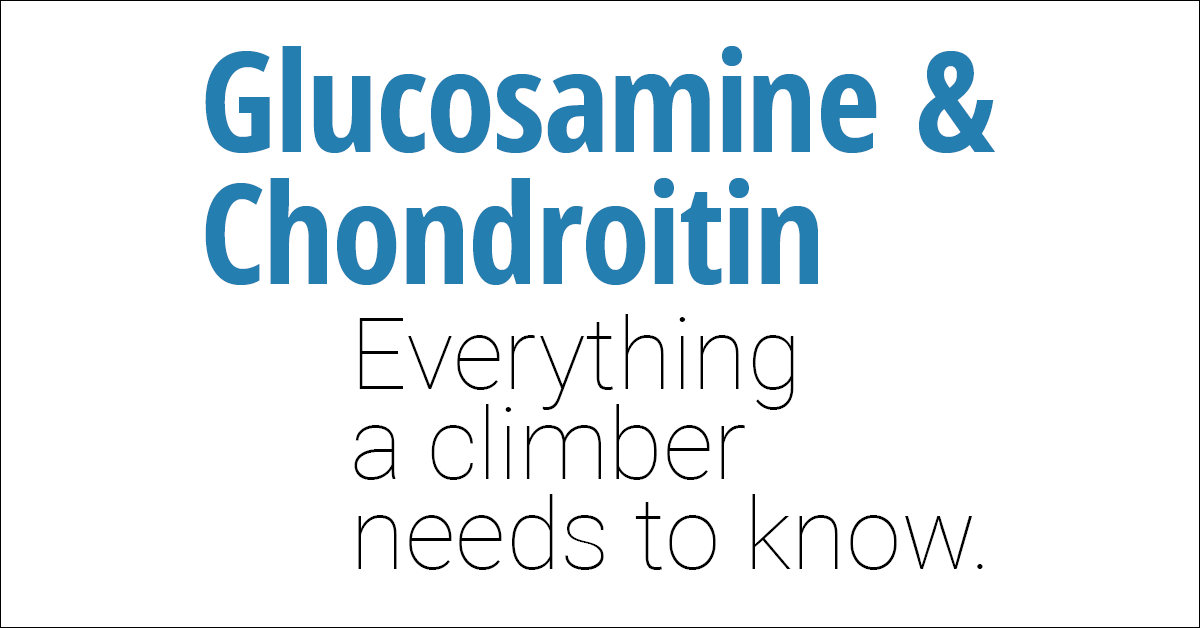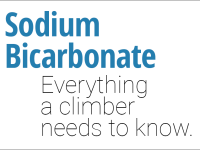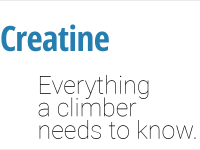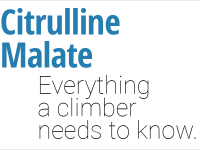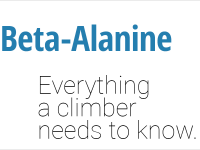Facts at a Glance
Glucosamine and chondroitin are touted as joint health supplements, but appear to only be effective in treating the specific form of joint damage common to osteoarthritis (cartilage degeneration)—and even there, the science is less than decided. The type of joint damage common to climbers cannot be repaired or prevented by glucosamine or chondroitin.
Best For
Treating cartilage degeneration resulting from osteoarthritis; reducing pain associated with osteoarthritis.
Strength of Evidence & Size of Effect
There is strong evidence that glucosamine and chondroitin are only minorly effective at reducing joint space narrowing as it occurs in osteoarthritis and reducing pain.
Dose
Glucosamine: 500 mg, 3x daily
Chondroitin: 200-400 mg, 3x daily
Recommendation for Climbers
Glucosamine and chondroitin cannot and will not repair or protect against tendon or ligament damage, only cartilage degeneration resulting from osteoarthritis. Since there is no evidence that climbing damages the cartilage, there is no reason to expect glucosamine or chondroitin to help a climber. NOT RECOMMENDED.
What Are Glucosamine & Chondroitin?
Glucosamine and chondroitin are two of the most popular supplements in the US, not just for humans but for our furry companions as well. In all cases, it’s marketed as a joint supplement, capable not only of soothing achy joints but possibly building joint strength and integrity.
Biologically speaking, glucosamine is a monosaccharide like glucose and fructose. Unlike glucose and fructose, however, we cannot use glucosamine for energy. Instead, it plays a structural role—albeit a different role in humans than in insects and crustaceans, where it is a major component of the chitinous exoskeleton.
Chondroitin is also a carbohydrate, but a more complex one (i.e., a chain) formed of alternating monosaccharides. Unlike glucosamine—which is a precursor molecule—our bodies use chondroitin [sulfate] itself to build cartilage.
Despite being discrete supplements, this supplement guide will review both because they are frequently used in combination and because many studies and meta-analyses also use both in combination.
What Are the Benefits of Glucosamine & Chondroitin?
Glucosamine and chondroitin have been studied in pursuit of three primary goals:
- Prevention of Osteoarthritis
- Reduced Progression of Osteoarthritis
- Pain Associated with Osteoarthritis
All three goals are directly related to osteoarthritis, and at this point there are few studies that have addressed either supplement outside of osteoarthritis. This is an early red flag for its popularity because osteoarthritis is a specific form of joint disease that does not occur in the majority of the population. Thus, even if these supplements were found to be effective in the case of osteoarthritis, we could not reasonably extrapolate those results to non-osteoarthritic joint problems as well.
Ultimately, this may be a null concern because the trials that have been done on glucosamine and chondroitin are still not overwhelmingly positive, even in the case of osteoarthritis. They are contradictory—and as many meta-analyses have found, they are also prone to industry bias and other errors. Before we discuss why so much of the science is poor, though, let’s cover what the studies say about each goal.
The first goal, prevention of osteoarthritis, has the least evidence both from the standpoint of total trials done and also supportive evidence. To be specific, there is one trial I could locate that attempts to elucidate whether glucosamine is effective in preventing osteoarthritis.1 The trial followed a group of overweight middle-aged females for two and half years and compared a combined glucosamine/weight loss/exercise trial with a placebo trial (still with the weight loss/exercise component). In the end, no significant difference between the two groups was found. This result isn’t promising, but neither is it necessarily a death sentence. Lone trials are, by themselves, not enough for conclusive results. Still, with 407 participants (and only 10% loss over the course of the trial) it’s a strong blow.
In reality, the case for glucosamine and chondroitin being chondroprotective (chondro means cartilage) is weak. Outside of osteoarthritis, there are few situations that will result in permanent degeneration of the cartilage. The vast majority of humans—whether they’re climbers, athletes in general, or sedentary—will never wear their cartilage out, and so it doesn’t really need “protecting”. At best, we might expect any chondroprotective effects of glucosamine and chondroitin to only kick in when a person develops osteoarthritis, making these supplements sort of a long-shot gamble—wondering not only whether you’ll develop osteoarthritis at all, but also when. There could be 20 years between now and the point these supplements could work in this way, and in all that time between they’ll be doing nothing.
The second goal, reduced progression of osteoarthritis, has better evidence. One of the main markers used to determine whether progression has been stalled is joint space narrowing—essentially, if the joints narrow less in one group than another, it indicates that less cartilage has been lost, and that disease progression is slowed. Numerous studies (three referenced here) have found that glucosamine, chondroitin, or their combination reduces joint space narrowing,2–4 which is potentially good news. Other studies disagree with these results, however, and find no significant or meaningful reduction in joint space narrowing.5,6
In situations like these, it’s helpful to turn to meta-analyses that can take a bulk of studies and parse them for actual effect. Thankfully, we have a preponderance of such analyses to turn to!7–16 Unfortunately, they’re just as divided in conclusion. Before we throw our hands up in despair and give up, though, we can still see where they agree and what reasons they have for disagreeing. After all, all these meta-analyses are pulling from the same pool of trials, give or take a few.
The main disagreement between the meta-analyses was the size of effect, or how strongly glucosamine and chondroitin reduce joint space narrowing. The most positive of the meta-analyses appear to show a significant and large effect, but most show only a small or moderate effect. The discrepancy may seem curious, but those same meta-analyses that show only small effect (or no effect) give a few reasons for why the other analyses might have had different results: 12,15,16
- They note that there was a large amount of heterogeneity in the trials they pulled from, which essentially means the studies were too different to compare. This may mean they used different preparations, or doses, or timing, or any of a number of other reasons, but regardless of the exact reason it weakens the meta-analysis as a whole. When heterogeneity is addressed, the apparent effect size diminishes.
- There was a significant amount of industry bias, as in trials that were funded by players with a stake in glucosamine and chondroitin typically produced far better results than independent trials. Industry bias is common and well-known, but not necessarily the end of the world especially when it can be detected. In our case here, though, it serves as an example of how it can skew the results towards outcomes desirable by the industry.
- Different trials used different preparations of glucosamine and chondroitin, and not all of them appear equally effective. This could be more industry bias, but it’s also possible that it’s simply indicative of the general quality problem the supplement industry in the US has—not every supplement contains what it says it will, and if you don’t purchase from a trusted manufacturer you may be scammed. In the trials, the most effective preparation was produced by the European pharmaceutical company Rottapharm, which is likely to have effective quality control in place to ensure product efficacy.
Just as telling as these reasons given by the less positive meta-analyses is that they are not mentioned at all by the highly positive ones. They are still problems endemic to glucosamine and chondroitin trials, but they are missed, ignored, or glossed over by meta-analyses interested in painting these supplements in a positive light.
Despite the problems, however, it seems likely that glucosamine and chondroitin are at least somewhat effective at reducing joint space narrowing, though it may not be enough to make taking them worth it. The main take-away of the most negative meta-analyses, after all, was that there wasn’t enough of a clinical difference in disease progression to warrant the use of glucosamine or chondroitin, and as such, patients should be steered away—in other words, that even if joint space narrowing was reduced, it made no real world difference to the patient’s health or condition.
The final goal, reducing the pain associated with osteoarthritis, follows a similar curve as the above goal. The same problems plague those trials (which are often the same trials), and the conclusions are just as contradictory. Again, the Rottapharm preparation has the most evidence,17 and other preparations appear far less effective.
Still, unlike joint space narrowing, pain can be felt acutely, and this makes it more possible to trial glucosamine and chondroitin to see for yourself (placebo effects aside). The relief is likely to be small, but since these supplements have no adverse effects (unlike the common analgesics prescribed for osteoarthritis) it may be worth trying if your own pain is not too severe. Most doctors who would recommend a supplemental solution recommend a 6-month trial—if you don’t feel a noticeable difference by then, you probably never will.
Are Glucosamine and Chondroitin Worth It for Climbers?
Given that glucosamine and chondroitin are, at best, only somewhat effective at treating joint problems—and even then, only the specific type of cartilage degeneration seen in osteoarthritis—it’s reasonable to question whether they have any utility at all for climbers. A quick look at the evidence suggests that they do not.
To begin with, it doesn’t appear that climbing itself increases a person’s risk for developing osteoarthritis (and exercise, in general, is associated with lower risk). 18,19 These two studies found no difference in the rate of osteoporosis between climbers and non-climbers, indicating that there is nothing special about climbing that would increase risk.
A third study that is more recent than the other two did find an increased rate of osteoarthritis among climbers, but with an extremely important caveat: there was no change in joint space narrowing.20 Instead, the only signs were found in the bones themselves, such as bony growths characteristic of osteoarthritis, a problem that glucosamine and chondroitin cannot resolve.
(You can reduce the odds of developing these bone growths by avoiding full crimps [thumb on finger] and ideally trying to always keep that PIP joint [second joint from the fingertip] flexed less than 80-90° and the DIP joint [first joint from the fingertip] always flexed 5-15°—but it should also be noted that these issues only rarely cause pain or discomfort, and almost never need to be removed.)21
So even if climbers are more likely to develop osteoarthritis—which is contentious—the way their osteoarthritis manifests isn’t related to the finger cartilage and glucosamine and chondroitin cannot help. Ergo, these supplements cannot help most climbers outside of the few who have confirmed joint space narrowing in the fingers (and even then, it’s unlikely to help much).
Adverse Effects
Glucosamine and chondroitin are very safe. Some researchers have hypothesized that glucosamine could induce insulin resistance (because it competes with glucose for transport into the cell), but this has never been shown to occur in vivo, probably in part because you typically only take about 1.5 grams of glucosamine a day, which is hardly enough to swamp your insulin.
Another concern is that glucosamine (but not chondroitin) is often made from the shells of crustaceans, and while it itself is not allergenic there could be residual traces of shellfish allergens. If you have an allergy to shellfish, it’s possible you could have a reaction and you should proceed with caution when trying a new glucosamine supplement.
Dosage
The standard dose for glucosamine is 1,500 milligrams a day, usually divided into three doses of 500 milligrams each.
The standard dose for chondroitin is 800 to 1,200 milligrams a day, usually divided into three doses of 200-400 milligrams each.
It doesn’t appear to matter whether you take the supplements with or without food, which is to be expected since a supplement needs to be effective in the first place before timing becomes important.
For any hope that this product will be effective, it needs to be taken long-term. There are no short-term benefits, and any possible benefits will disappear once you cease supplementation.
How to Choose the Right Product
Earlier I wrote that the studies suggest that some forms of glucosamine and chondroitin are more likely to be effective than others. Specifically, the preparation found to be most effective is a pharmaceutical form available in Europe from the manufacturer Rottapharm. It’s also possible that this is industry bias, and that the reality is that the Rottapharm preparation is no more effective than any other preparation, which is to say not very effective at all.
If you cannot get the Rottapharm preparation, and you’re still interested in trying glucosamine and chondroitin, then make sure you get glucosamine sulfate and chondroitin sulfate which are better absorbed and utilized than other forms.
I will repeat again here, these supplements are only possibly effective in slowing down the progression of osteoarthritis and reducing pain—not for preventing osteoarthritis in the first place. If you do not have osteoarthritis, no form of glucosamine and chondroitin will be effective, and there is no “right product”.
Conclusion
Glucosamine and chondroitin are supplements you really want to work—it’d be nice to have a solid joint-repair supplement to pull from—but the evidence that they will actually help climbers or their joints is scant. Instead, it appears that the form of joint damage glucosamine and chondroitin can potentially help (cartilage degeneration leading to joint space narrowing) is not a common issue for climbers, and thus there will be little if any effect.
If you are a climber and you’ve been diagnosed with osteoarthritis and you have radiological signs of joint space narrowing in the finger joints, it may be worth trying glucosamine and chondroitin. They are safe (outside of the potential for shellfish allergies) and could delay further degeneration or relieve pain. If you decide to try them, don’t give them more than six months to demonstrate their efficacy.
The bottom line is that glucosamine and chondroitin are a waste of money for most climbers, and it’s unlikely they’ll actually help the joints in any way, shape, or form. I recommend against taking them unless you have verified signs of joint space narrowing in the finger joints.
